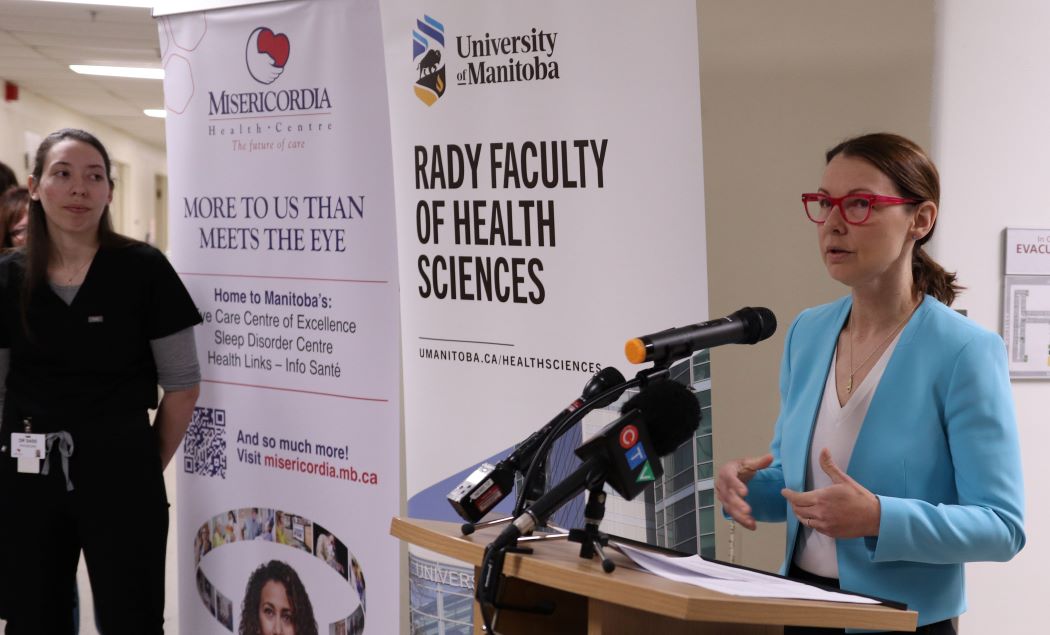
Dr. Sarah-Jane Sass (left), the first sleep medicine fellow at UM, waits to speak as Dr. Nancy Porhownik, sleep specialist and UM faculty member, announces the fellowship.
New UM fellowship gives boost to sleep medicine in Manitoba
A new fellowship is making it possible for more Manitoba patients to be assessed and treated for sleep disorders, the University of Manitoba and Misericordia Health Centre announced at a news conference on April 9.
The Royal College of Physicians and Surgeons of Canada recently accredited the section of respirology at UM – part of the department of internal medicine in the Max Rady College of Medicine – to start training one fellow per year to be certified in the sub-specialty of sleep medicine.
UM is one of six Canadian universities – including the University of British Columbia, University of Calgary, McMaster University, University of Ottawa and Western University – to receive this new accreditation.
“Being able to offer this fellowship in sleep medicine increases the number of physicians at the provincial Sleep Disorder Centre at Misericordia Health Centre from seven to eight,” said Dr. Nancy Porhownik, a sleep specialist who is assistant professor of internal medicine and co-section head of respirology.
“This training program also makes us competitive in the recruitment of sleep medicine specialists from other places in Canada. Academic sleep medicine doctors are in high demand … because they provide patient care, but also teach and do research.”
Calling the fellowship “a first for Manitoba,” Minister of Health, Seniors and Long-Term Care Uzoma Asagwara welcomed the UM accreditation.
“Fellowships like this are an important part of our government’s priority of attracting and retaining the best and the brightest minds to be here in Manitoba,” Asagwara said.
Adding the UM-based fellow to the team at the Sleep Disorder Centre is helping to reduce wait times for Manitobans who need a sleep study and follow-up care, Porhownik said.
A sleep study, sometimes done in a lab at Misericordia and sometimes by the patient at home, is a diagnostic test that captures data such as brain waves, blood oxygen levels, breathing patterns and leg movements while the patient sleeps.
The UM fellow will gain expertise in assessing, diagnosing and managing sleep disorders such as insomnia, narcolepsy, circadian rhythm (body clock) disorders, breathing disorders like sleep apnea and movement disorders like restless legs syndrome.
Before the Royal College approved the new training program at the six universities, certification in sleep medicine was not available in Canada. Porhownik had to challenge her sleep medicine exams in the United States.
To be eligible for the sleep medicine fellowship at UM, applicants must first complete a four-year medical degree, then a medical residency and specialty training.
Dr. Sarah-Jane Sass, the first fellow to be accepted, started her fellowship about three months ago. She became fascinated with sleep medicine, she said, when she did rotations through the Sleep Disorder Centre during her two-year specialization in respirology.
“It’s such a rapidly developing field, and it’s extremely rewarding,” Sass said. “Sleep quality affects everyone and … is also linked to many other health conditions, such as heart disease.”
Sass, who is from Ontario, plans to continue practising sleep medicine in Winnipeg after she completes her fellowship.
The sleep specialist physicians at the Sleep Disorder Centre review more than 2,600 hospital sleep studies and more than 2,200 home sleep studies annually. They assess and treat more than 10,000 new and existing patients each year.
Media personality Charles Adler spoke at the news conference, crediting doctors at the Sleep Disorder Centre with saving his life more than 20 years ago. He recalled suffering from terrible headaches, vision problems and blackouts at the time.
After a sleep study at the Misericordia revealed that his breathing was stopping frequently as he slept – meaning that he had sleep apnea – Adler got the life-changing care he needed.
“I wish more people knew about sleep disorders, including sleep apnea,” he said. “Many people are dying of heart attacks and strokes.… But the fact is, they wouldn’t be having those heart attacks and strokes if they could breathe properly.”






